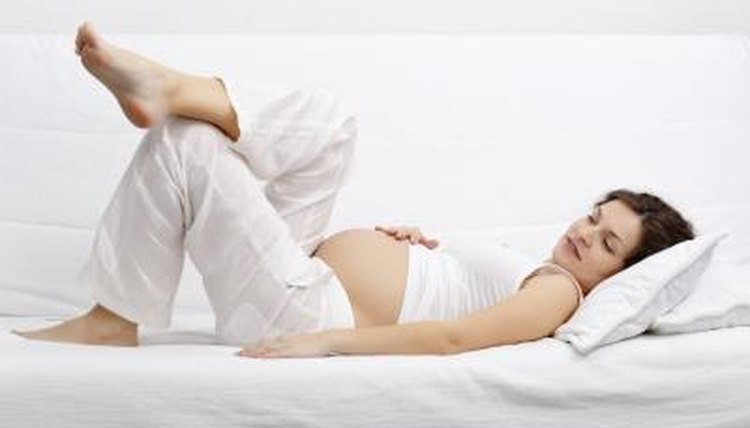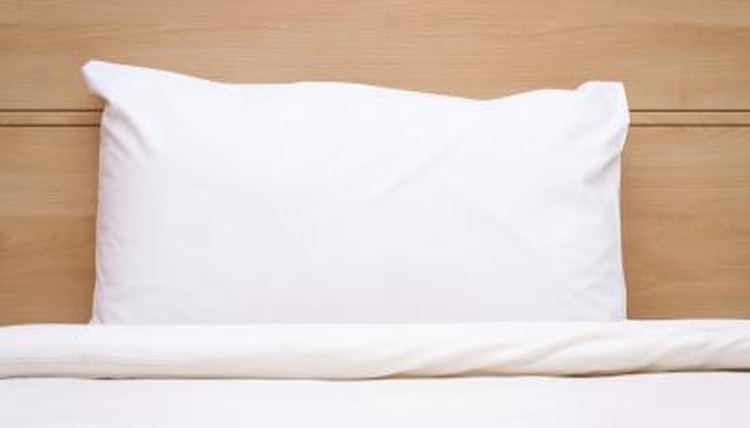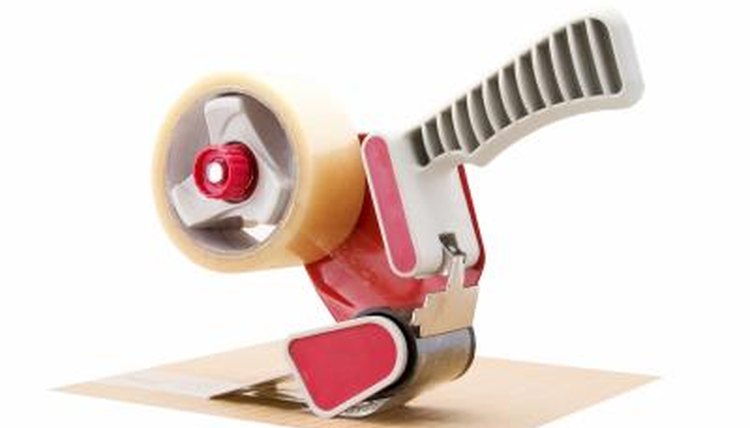How to Elevate the Foot While Sleeping

A variety of conditions from a broken ankle to pregnancy or gout can necessitate elevating of your foot. Doctors typically recommend raising your affected foot above heart level to prevent swelling and pooling blood. Elevating your foot during the day is easy, but doing so while asleep is a bit more challenging. Keeping your foot raised throughout the night isn't difficult, but does require understanding your own sleep patterns to ensure consistent and proper elevation of your foot.

Sergey Borisov/iStock/Getty Images
Find a firm and supportive pillow on which to rest your feet. Avoid feather or down pillows, which sink easily, thus lowering your elevated foot. Pillows made of memory foam are also a good choice for a supportive resting place. Use a longer king-sized pillow, if possible, as it will keep your foot elevated if you roll over while sleeping. If necessary, safety pin the cases of two pillows together to achieve the proper height.

Sergey Borisov/iStock/Getty Images
Place the pillow under your knees, which will cause your foot to rise. Your knee is a natural bending point in your lower leg, and a good place for elevated support. Avoid placing the pillow under your foot only without supporting the rest of your lower leg, because this set-up places unnecessary strain on your unsupported knee.

Sergey Borisov/iStock/Getty Images
Make four loops of packing tape and place them on the bottom corners of the pillow. Press the adhesive-backed pillow into your mattress before moving your knee on top. If you are a restless sleeper, the adhesive backing will prevent the pillow from sliding out of position while you sleep.
Tips
Even if only one foot requires elevation, some people find raising both feet is an easier and more comfortable position to hold while sleeping.
References
- American Academy of Orthopaedic Surgeons: Stress Fractures of the Foot and Ankle
- American Academy of Foot and Ankle Surgeons: Gout
- Collins KK, Liu Y, Schootman M, et al. Effects of breast cancer surgery and surgical side effects on body image over time. Breast Cancer Res Treat. 2011;126(1):167-76. doi:10.1007/s10549-010-1077-7
- Wang L, Guyatt GH, Kennedy SA, et al. Predictors of persistent pain after breast cancer surgery: a systematic review and meta-analysis of observational studies. CMAJ. 2016;188(14):E352-E361. doi:10.1503/cmaj.151276
- Harvard Medical School Harvard Health Publishing. Lymphedema. Published December 2018.
- Durning MV. Coping with pain after breast cancer surgery. Memorial Sloan Kettering Cancer Center. Published July 28, 2015.
- Moyer KE, Potochny JD. Technique for seroma drainage in implant-based breast reconstruction. J Plast Reconstr Aesthet Surg. 2012;65(12):1614-7. doi:10.1016/j.bjps.2012.06.016
- Mangone M, Bernetti A, Agostini F, et al. Changes in spine alignment and postural balance after breast cancer surgery: a rehabilitative point of view. Biores Open Access. 2019;8(1):121-128. doi:10.1089/biores.2018.0045
- Centers for Disease Control and Prevention. What is venous thromboembolism? Updated February 7, 2020.
- Di Nisio M, van Es N, Buller HR. Deep vein thrombosis and pulmonary embolism. The Lancet. 2016;388(10063):3060-3073. doi:10.1016/S0140-6736(16)30514-1
- US Food and Drug Administration. TAXOL® (paclitaxel) injection. 2011.
- Dews T. When to suspect your lower back pain is actually sciatica. Cleveland Clinic. November 13, 2017.
- Mcquade RM, Stojanovska V, Abalo R, Bornstein JC, Nurgali K. Chemotherapy-induced constipation and diarrhea: pathophysiology, current and emerging treatments. Front Pharmacol. 2016;(7):414. doi:10.3389/fphar.2016.00414
- Bodai BI, Tuso P. Breast cancer survivorship: a comprehensive review of long-term medical issues and lifestyle recommendations. Perm J. 2015;19(2):48-79. doi:10.7812/TPP/14-241
- Zocca J. A review of recent advances in the management of breast cancer related pain. Breast Cancer Management. 2018;7(2). doi:10.2217/bmt-2018-0003
- Kulkami A, Pusic A, Hamill J, et al. Factors associated with acute postoperative pain following breast reconstruction. JPRAS Open. 2017;11:1-13. doi:10.1016/j.jpra.2016.08.005
Tips
- Even if only one foot requires elevation, some people find raising both feet is an easier and more comfortable position to hold while sleeping.
Writer Bio
Christina Bednarz Schnell began writing full-time in 2010. Her areas of expertise include child development and behavior, medical conditions and pet health. She holds a Bachelor of Arts in international relations.
